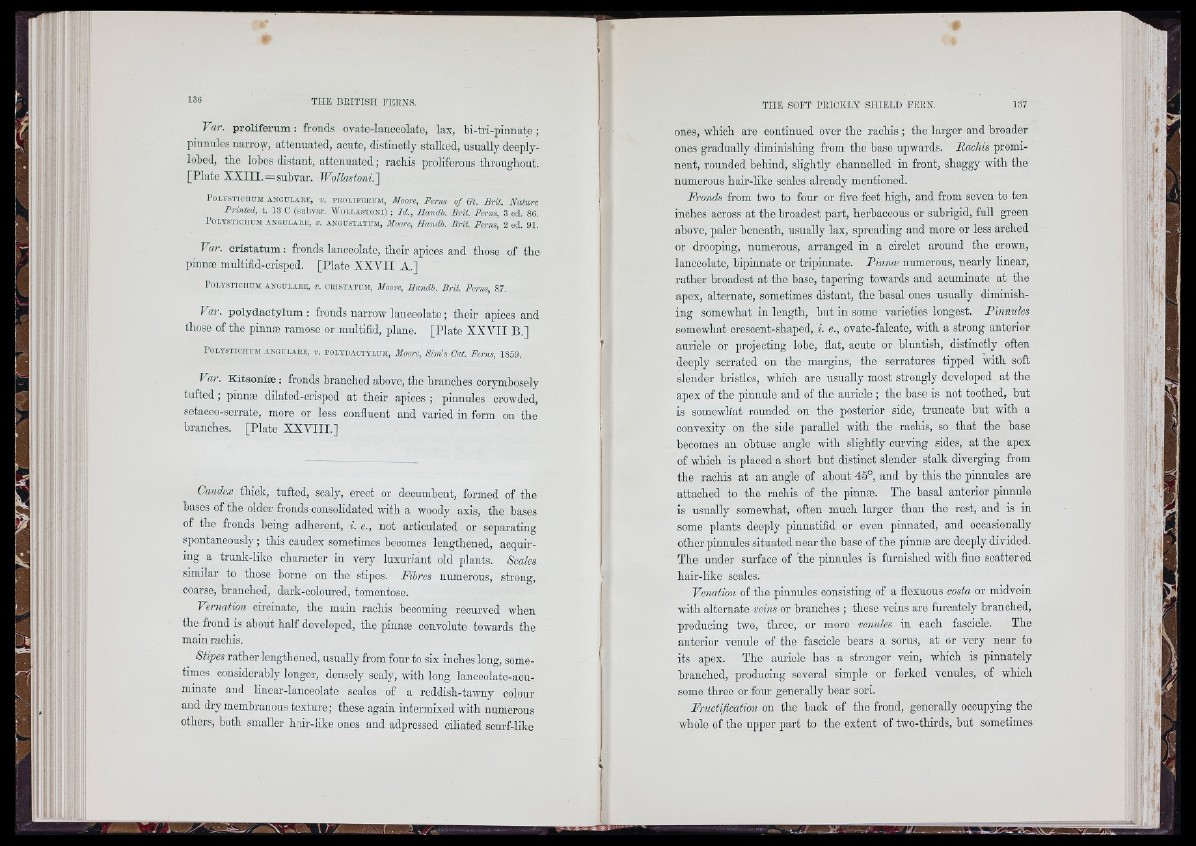
Va?\ proliferum : fronds ovato-lanoeolate, lax, bi-tri-pinnate ;
pinnules narrow, attenuated, acute, distinctly stalked, usually deeply-
lobod, tbo lobos distant, attenuated ; raohis proliferous throughout.
[Plato X X III. = sub var. }VoUastoni.)\
F o ly s t i c i i t im ANGULARE, V. PROLIFERUM, Moore, Perils o f Gt. BrU. Nature
Printed, t. 13 0 (su b v ar. W o l l a s t o n i ) ; Id ., Handh. Brit. Ferns, 3 ed. 88.
P o ly st ic iium a n g u la r e , ®. angustatum , Moore, Ilandh. Bril. Ferns, 2 ed. 91,
Var. cristatum : fronds lanceolate, their apices and those of the
pinnæ multifid-crisped. [Plate X XV II A.]
P o l y s t i c i i u m a n g u l a r e , v . c r i s t a t u m , Moore, llandb. Brit. Perm, 87.
Var. polydactylum : fronds narrow lanceolate ; their apices and
those of tho pinnæ ramose or multifid, plane. [Plate X X V II B.]
P olystichum a n g u la r e , ». poly'dactylum, Moore, S im ’s Cat. Ferns, 1859.
Var. Kitsoniæ : fronds branched above, the branches oorj'mbosely
tufted ; pinnæ dilated-crisped at their apices ; pinnules crowded,
setaceo-serrate, more or less confluent and varied in form on the
branches. [Plate X X V III.]
Caudex thick, tufted, scaly, erect or decumbent, formed of the
bases of the older fronds consolidated with a woody axis, the bases
of the fronds being adherent, i. e., not articulated or separating
spontaneously ; this caudox sometimes becomes lengthened, acquiring
a trunk-like oharaoter in very luxuriant old plants. Seales
similar to those borne on the stipes. Fibres numerous, strong,
coarse, branched, dark-coloured, tomentose.
Vernation cii'cinate, the main rachis becoming recurved when
the frond is about half developed, the pinnæ convolute towards the
main raohis.
Stipes rather lengthened, usualfy from four to six inches long, sometimes
considerably longer, densely scaly, with long lanceolate-acuminate
and linear-lanceolate scales of a reddish-tawny colour
and dry membranous texture; these again intermixed with numerous
others, both smaller hair-like ones and adpressed ciliated scurf-like
tax" j". \ 1
ones, which aro continued over the raohis ; the larger and broader
ones gradually diminishing from the base upwards. Bachis prominent,
rounded behind, slightly channelled in front, shaggy with the
numerous hair-liko scales already mentioned.
Fronds from two to four or five feet high, and from seven to ton
inches across at the broadest part, herbaceous or subrigid, full green
above, paler beneath, usually lax, spreading and more or less arched
or drooping, numerous, arranged in a circlet around the crown,
lanceolate, bipinnate or tripinnate. Pinnm numerous, nearly linear,
rather broadest at the base, tapering towards and acuminate at the
apex, alternate, sometimes distant, the basal ones usually diminishing
somewhat in length, hut in some varieties longest. Pinnules
somewhat crescent-shaped, *. e., ovate-faloato, with a strong anterior
auricle or projecting lobe, flat, acute or bluntish, distinctly often
deeply serrated on the margins, the serratures tipped with soft
slender bristles, which aro usually most strongly developed at the
apex of the pinnule and of the auricle ; the base is not toothed, hut
is somewhat rounded on the posterior side, truncate but with a
convexity on the side parallel with the rachis, so that the base
becomes an obtuse angle with slightly curving sides, at the apex
of which is placed a short but distinct slender stalk diverging from
the rachis at an angle of about 4-5°, and by this the pinnules are
attached to the rachis of the pinnæ. The basal anterior pinnule
is usually somewhat, often much larger than the rest, and is in
some plants deeply pinnatifid or even pinnated, and occasionally
other pinnules situated near the base of the pinnæ are deeply divided.
The under surface of the pinnules is furnished with fine scattered
hair-like scales.
Venation of tho pinnules consisting of a flexuous costa or midvein
with alternate veins or branches ; these veins are furcately branched,
producing two, three, or more venules in each fascicle. The
anterior venule of tho fascicle bears a sorus, at or very near to
its apex. The auricle has a stronger vein, which is pinnately
branched, producing several simple or forked venules, of which
some three or four generally hear sori.
Fructifleation on the back of the frond, generally occupying the
whole of the upper part to the extent of two-thirds, but sometimes
i l l